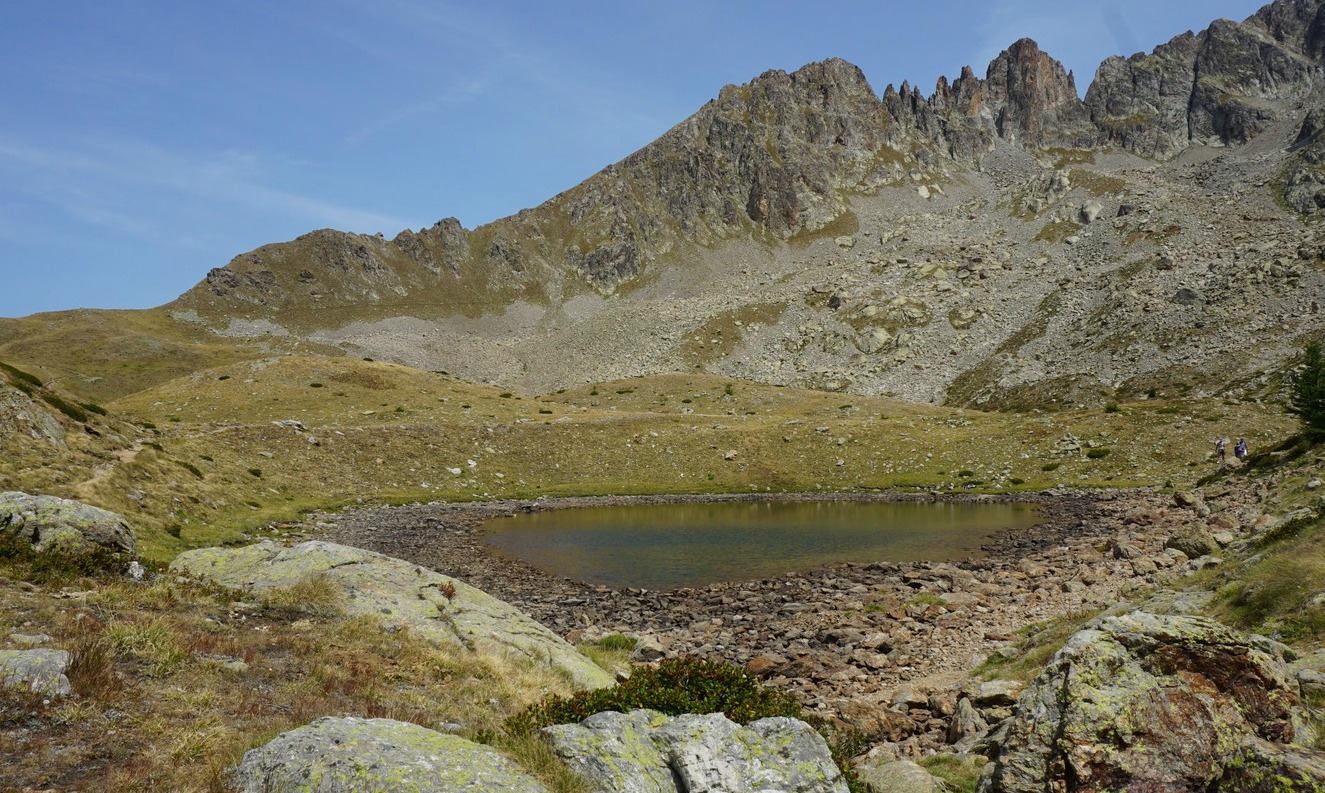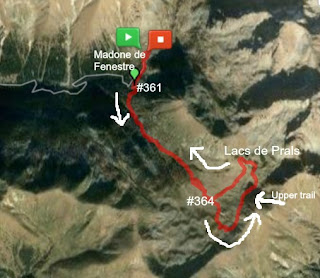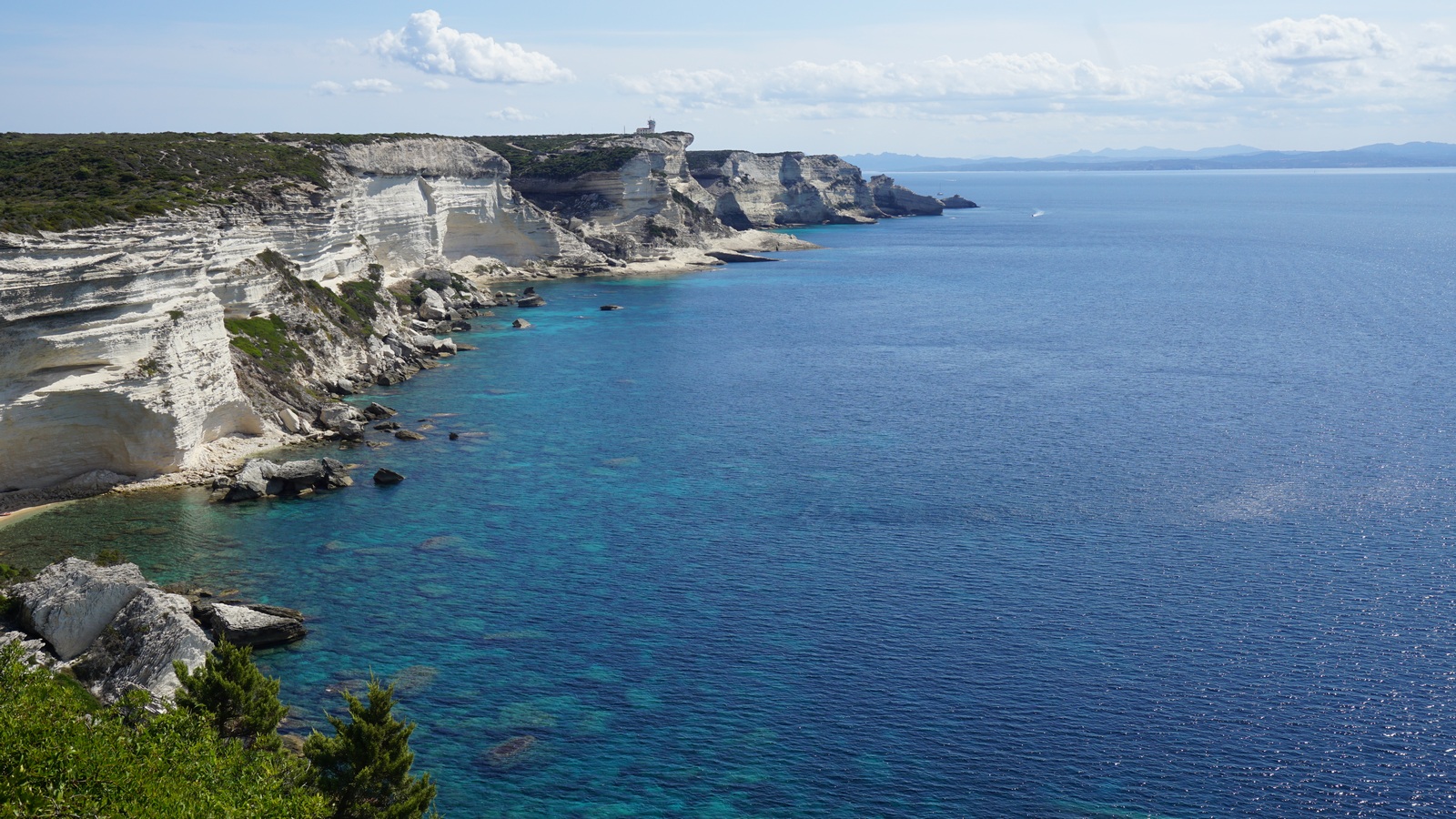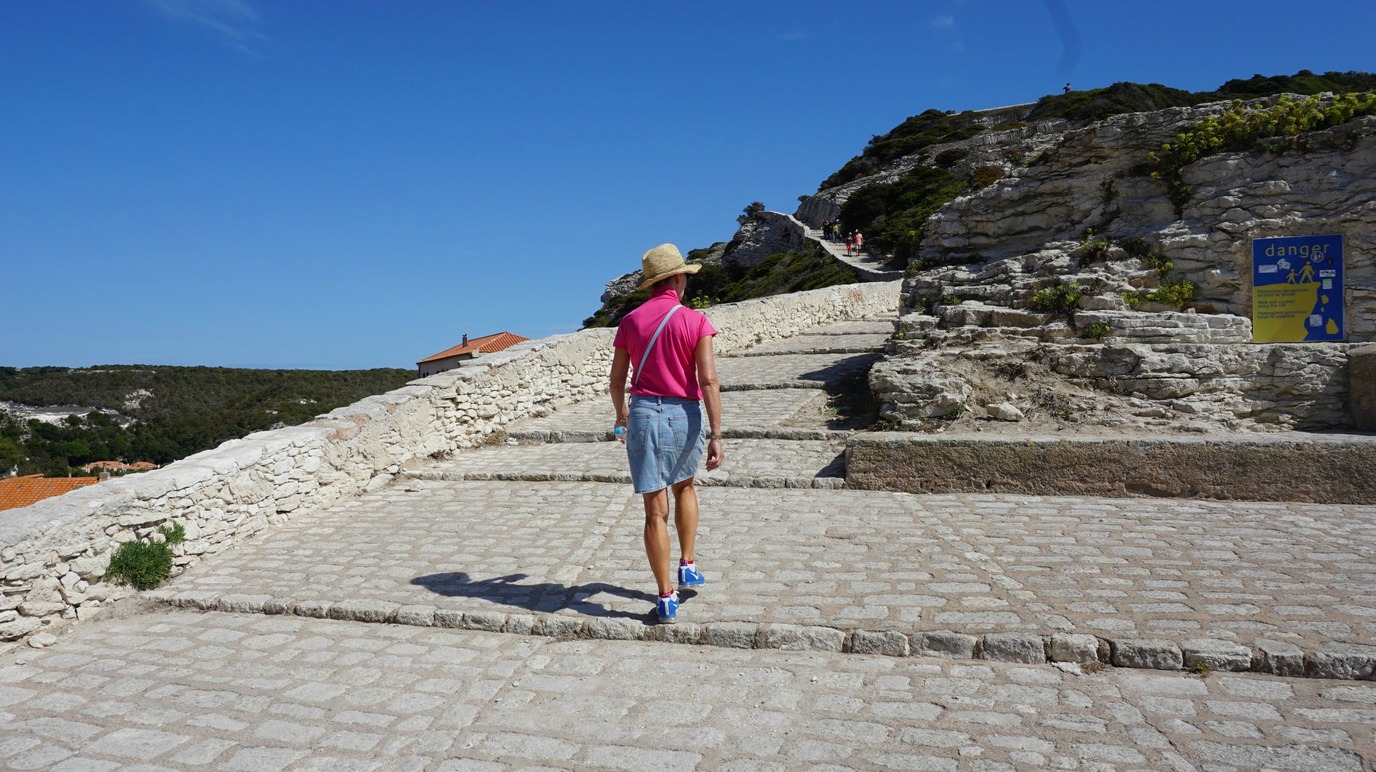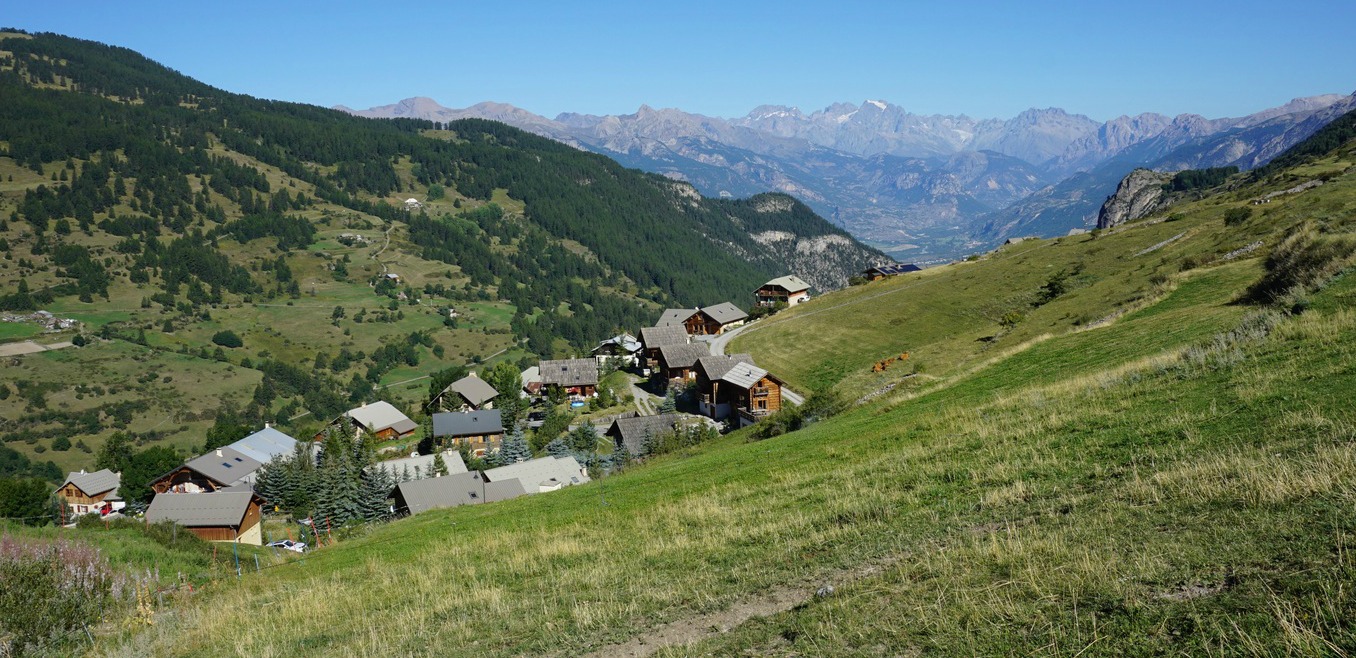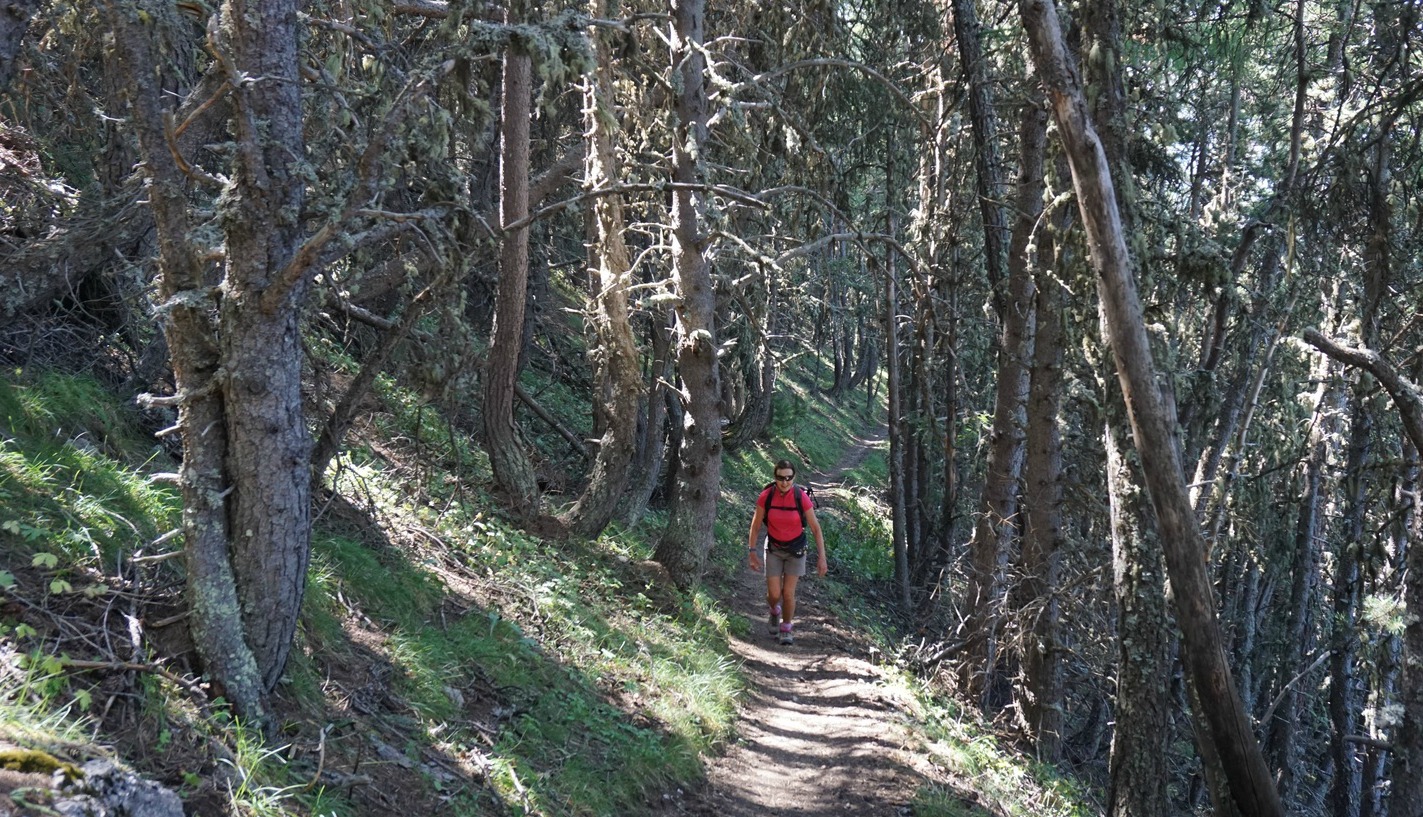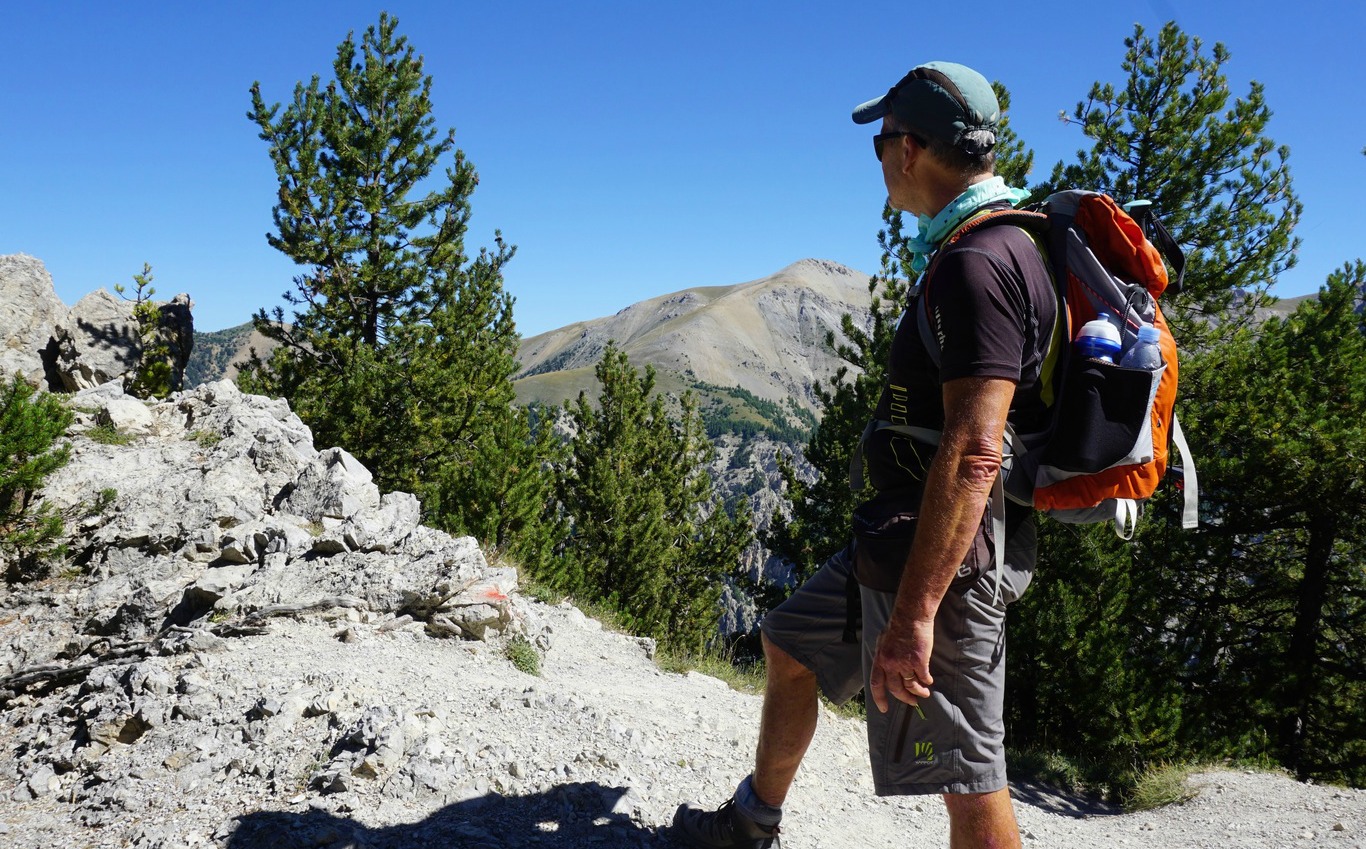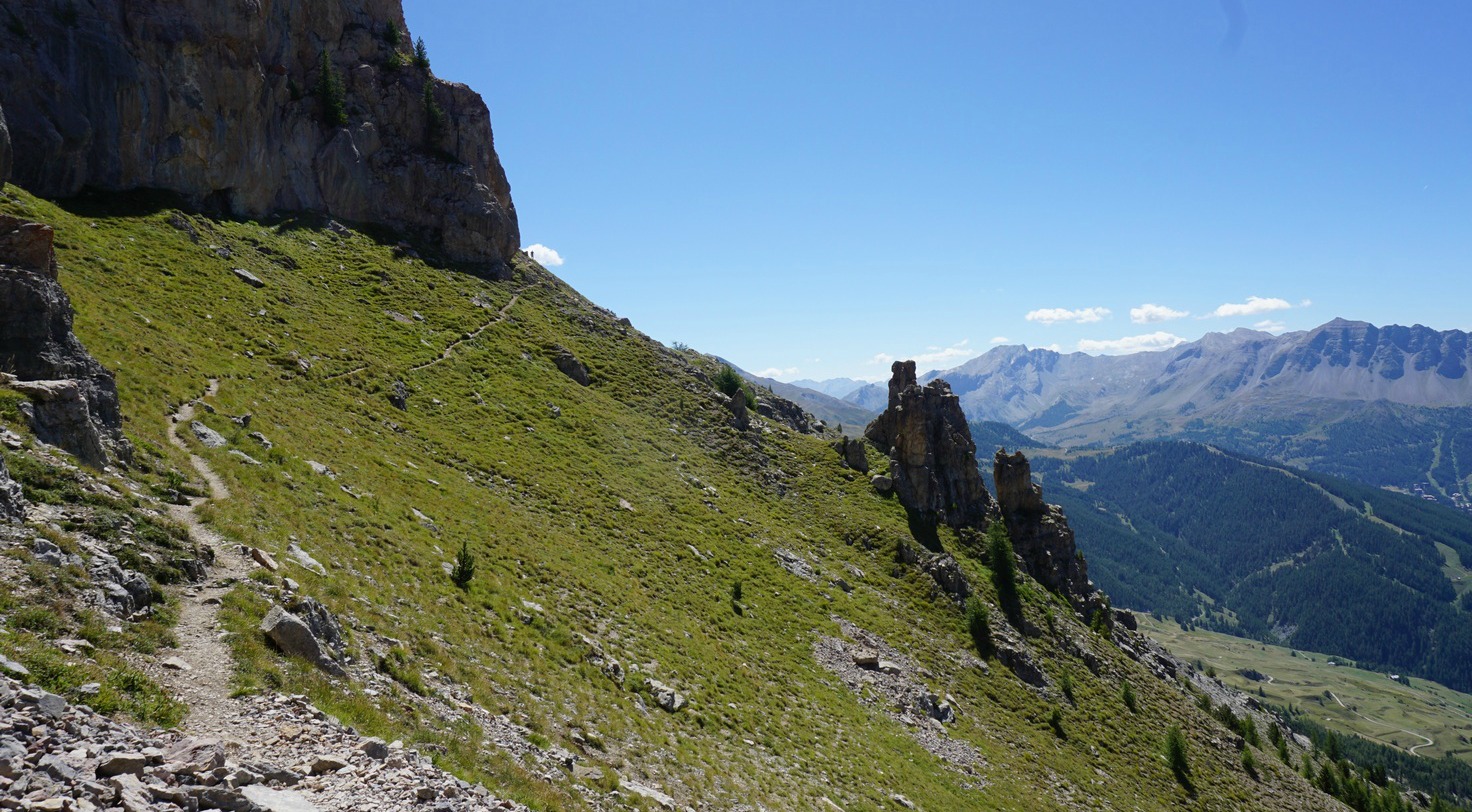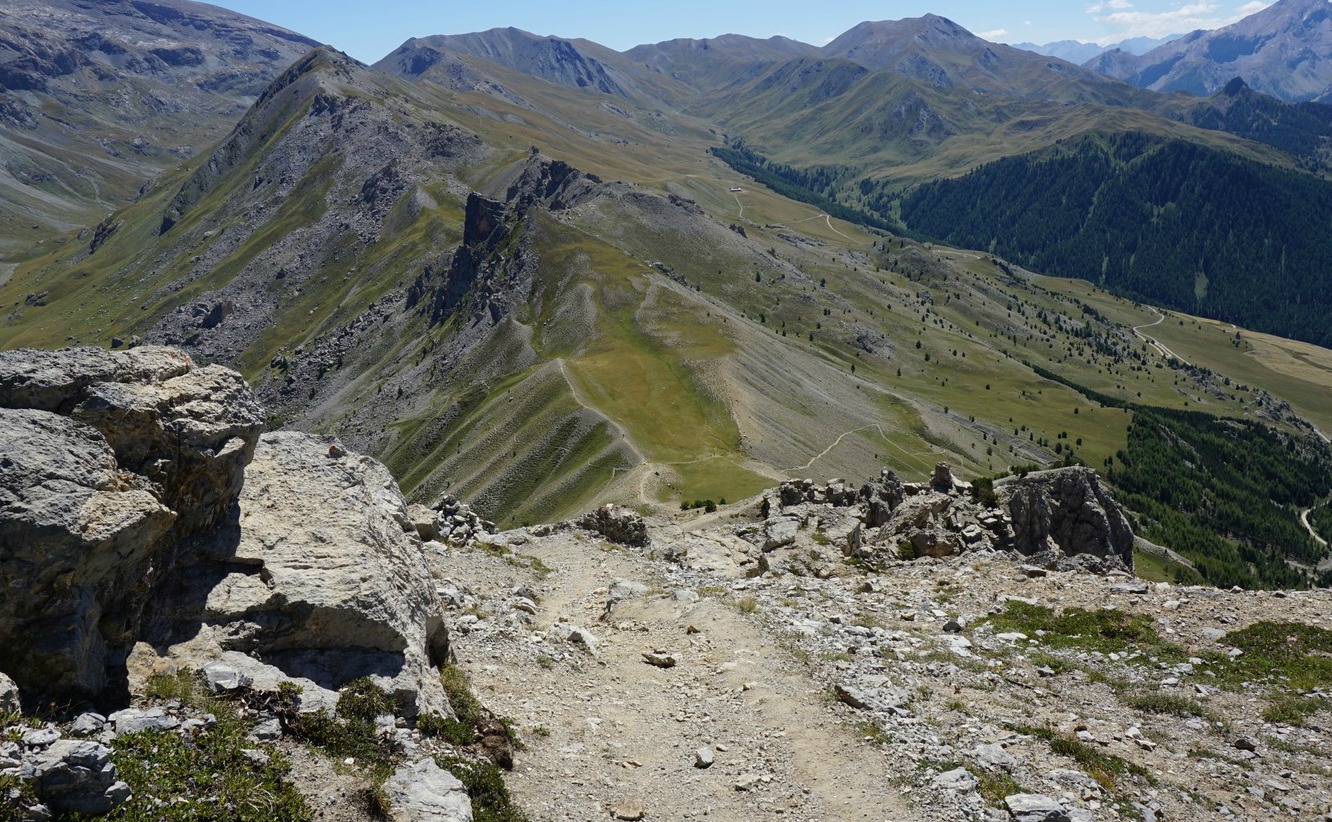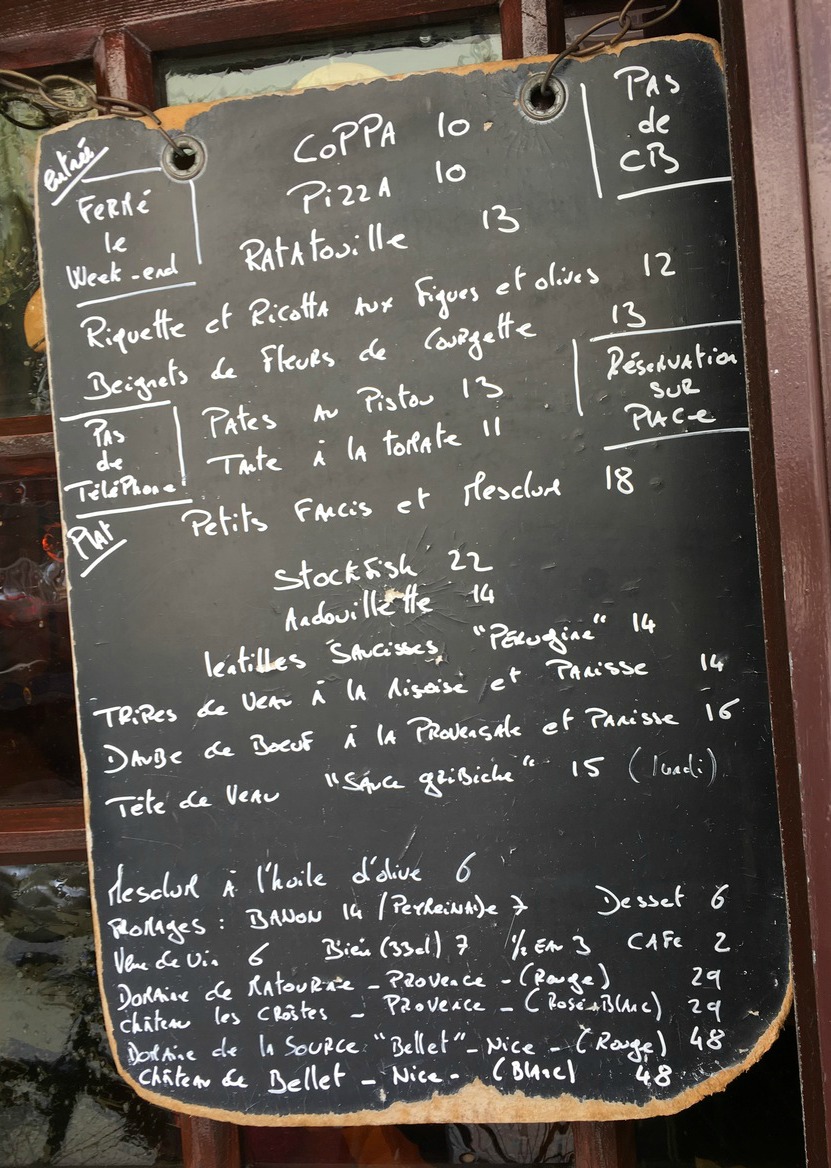
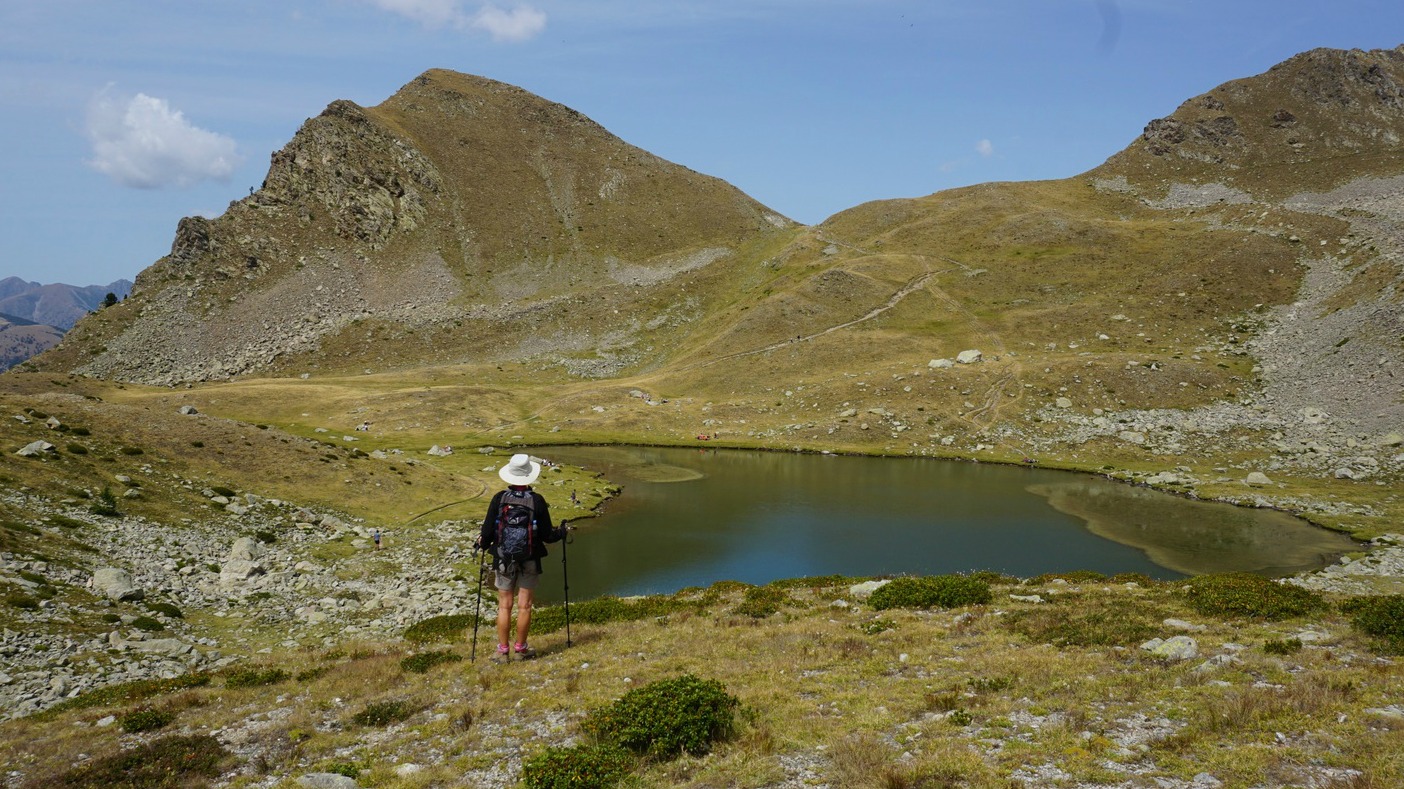
The Chapelle de Madone de Fenestre (1904 m) is a good starting point for several interesting hikes. The two most popular itineraries comprise the trails to Col de Fenestre at the Italian border, and Lacs de Prals southeast of the sanctuary.
The network of trails around Madone de Fenestre allows you to tailor-make your hike.
The Prals Lakes consist of 5 lakes in a basin at about 2200 m elevation, surrounded by majestic peaks. From Madone, the lakes can be reached from the north, along the trail along Vallon du Ponset, or as we did this time, from signpost #361 (1820 m) below Madone de Fenestre.
We ascended along a good trail familiar to us along Vallon de Prals, passing signpost #362, then 363. We came to a vast alpine meadow called Plan de Prals and continued to signpost #364 and a crossroads. From here, you can head directly to the lakes by taking the left-hand trail. We continued straight towards Baisse de Prals. However, just before reaching this mountain pass, we forked left along a good trail that was marked with a cairn at the crossroads. The direction was straight towards the lakes. In places, we had to negotiate rocky parts of the trail, but reached the upper smaller lake soon enough.
We felt that for a moderate effort we got great views, and the atmosphere of high mountain summits. It is simply stunning every time! This detour was much less used compared with the main artery to the lakes.
Needless to say, Lacs de Prals was a perfect spot for picnic for us and numerous other mountain lovers.
We headed back along the main trail to signpost #364, thus closing our little extra loop. We then took the same trail back to our starting point.
Duration: 3h 30
Elevation gain: 470 m
Distance : 9.6 km
Map: IGN Vallée de la Vésubie 3471 OT

The trail from Bonifacio to the southernmost tip of Corsica, Capu Pertusatu, is characterised as an easy stroll in some guidebooks. We agree with that. Hiking boots are not necessary, good jogging shoes suffice. It is a leisurely cliff walk with fantastic views to Bonifacio and over the strait to Sardinia.
Note that the tower seen from Bonifacio above the cliffs is an observation and radar tower of the French navy. The old lighthouse in Capu Pertusatu is a bit further away, and becomes visible when passing the military area.
We started from the Bonifacio Harbour, and walked around the old town before heading to the trail.
The trail started from Col Saint-Roch just above the harbour and below the old town. We first ascended along a wide cobbled trail. The path soon became narrower, levelling off, and we followed it, heading east. The military tower was visible most of the time, making navigation easy. There were no signposts. We eventually came to the D260 road near an intersection. Here, we forked right (south), following the road downhill for about 3 minutes. At a bend before the road starts climbing again, we forked left along a well visible trail, climbed a bit passing a ruined house before reaching the same road again. In fact, many tourists preferred to drive here, parking near the naval tower, obviously missing the great first part of the trail!
At this point, the old lighthouse was visible. We now followed a nice paved trail (cars not permitted) that took us directly to the lighthouse which was under restoration, and hence closed. We walked past its perimeter to the cliff which was our turning point today. It is possible to descend down to the beaches along trails that start before the lighthouse, or by continuing a bit further east to Cala di Labra, known for its overhanging sandstone cliff. All along the trail, mind the steep cliffs!
We returned to Bonifacio along the same trail.
Duration: 2h 30
Distance: about 9 km
Climb: about 200-250 m

The potato salad in this recipe reflects summer; it includes new potatoes, sliced radishes, and peas. It is much lighter than the classic potato salad made from potatoes and a mayonnaise dressing.
The roasted veal chops are served with pistou, basil purée. Here in Nice, I prefer veal chops which are usually more tender and succulent than pork chops in our local supermarket. The recipe works just as well with tender pork chops.
2 servings
2 thick veal chops (or pork chops)
Olive oil and butter for frying
For the pistou:
A small bunch of basil, chopped
2 tbsp. olive oil
1/3 clove of garlic, minced
Freshly ground black pepper
A pinch of salt
For the potato salad:
3 medium sized new potatoes, microwaved, then sliced
150 ml fresh peas
A small bunch of radishes, sliced
Basil leaves to decorate
For the dressing:
2 tbsp. olive oil
2 tsp red wine vinegar
1 tsp Dijon mustard
In a mortar, make the pistou by crushing the basil leaves and all the other ingredients with a pestle. Mix well, cover, and place in the fridge until needed.
Preheat the oven to 180° C.
Melt some butter and olive oil over medium- high heat in a heavy frying pan and fry the veal chops on both sides until golden brown. Transfer to an ovenproof dish and bake in the oven for 20 minutes. If using pork chops, make sure that they are well- done but not dry.
Meanwhile make the potato salad. Slice the microwaved new potatoes and transfer into a bowl. Peel the fresh peas into the bowl. Wash and slice the radishes and add to the bowl.
Whip together the dressing and add to the potato salad.
Transfer the veal chops on the plates and divide the pistou on top. Divide the potato salad on the plates and decorate with basil leaves.

This is a great autumn recipe when tomatoes are still tasty and fresh basil is available.
The sauce is made from fresh crushed tomatoes, tomates concassées. This involves placing the tomatoes in boiling water for three minutes or so, then peeling and roughly chopping them. It is amazing how easy it is to peel the tomatoes after they have been immersed in boiling water for a few minutes! The rest of the sauce ingredients; fresh basil, olive oil, black pepper, and spring onions, reflect Mediterranean flavours.
Covering the chicken breasts with fresh basil leaves, a slice of Parma ham, and olive oil before baking them keeps the chicken succulent and tasty.
2 servings
2 organic chicken breasts, without skin
2 slices of Parma ham
A handful of fresh basil leaves
About 4- 5 tbsp. olive oil
8 black olives, stoned and chopped
2 tasty tomatoes
2 spring onions, cébettes, white parts only
Freshly ground black pepper
Grated parmesan
Whole wheat spaghetti for two servings
Preheat the oven to 200° C.
Cover the chicken breasts with a slice of Parma ham and tuck a lot of fresh basil in between. Save some basil leaves for the crushed tomato sauce. Place the chicken breasts in an oven- proof dish and drizzle a table spoon of olive oil over each breast. Bake in the oven for 20 minutes.
Meanwhile cook the spaghetti and prepare the crushed tomato sauce.
Place the tomatoes in boiling water for about 3 minutes. Remove from the water, place in a bowl and peel them. Then chop roughly. Add the stoned and chopped olives, sliced spring onions, 2- 3 tablespoons olive oil, and black pepper. Carelessly mix the tomato sauce.
Chop the remaining basil and grate some parmesan.
Drain the cooked pasta and divide on the plates. Add the chopped basil in the tomato sauce and mix. Divide the tomato sauce on the pasta and sprinkle with parmesan. Place the chicken breasts on the side with some microwaved broccoli or butternut squash cubes.
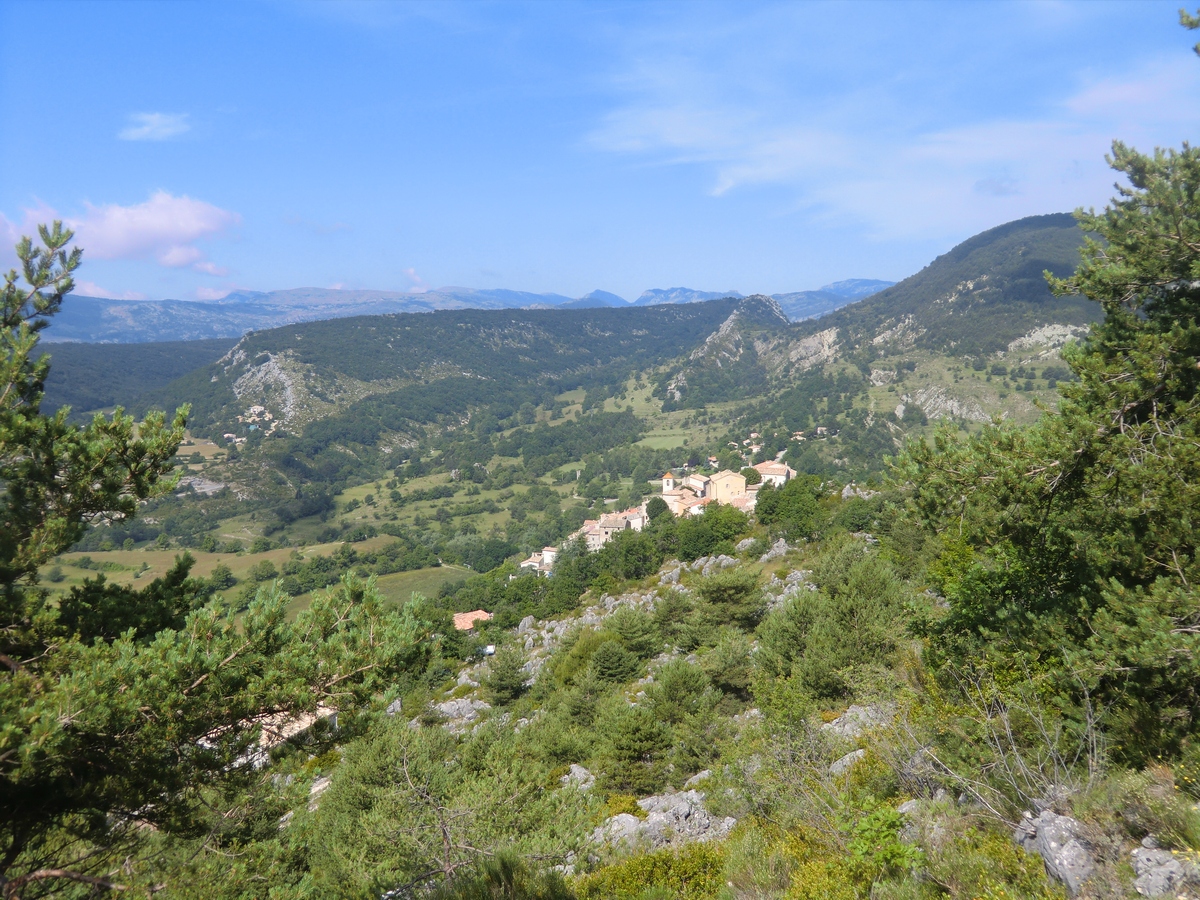
Sometimes, especially on a warm day, you might want to start your hike a bit higher but not drive far from the coast. The medieval perched village of Coursegoules north of Vence could then be your perfect choice. The village is said to be 700-800 years old but the original settlement was built by the Romans. The distance from Nice is 32 km by road, and the village is situated at 1020 m altitude under the eastern part of the Cheiron mountain ridge. The region is part of the Azur Prealps. The river La Cagne has its source southeast of the village. The village itself is certainly worth visiting. It is said to be less touristic. Even so, we saw quite a few visitors on the day of our visit. Some expats have found their home here.
The hike featured here ascends to the Cheiron ridge, follows it west before descending back to Coursegoules. The French guide calls the hike “Circuit de Viériou”. One of the advantages of this hike is that you rapidly reach the mountain crest; the whole walk takes about 3h 30 so you should have ample time to explore the village and even dine there.
From signpost 13 close to the parking, proceed to # 12 from where the well-marked trail starts ascending along the southern face of the mountain in the Foussa Valley. Signpost 145 at Baisse de Viériou (1356 m) on the ridge is reached in about an hour. The trail now heads northwest in an almost treeless landscape, climbing slightly to 1424 m, and the highest point of the hike. Eagles can frequently be spotted here, soaring above the mountain massif.
At signpost 146, there’s a crossroads where our itinerary winds down along a stony and wide path to signpost 147. Coursegoules is visible all the time. Even so, follow the path with yellow marks. There may be several paths, both man –and animal made. The tiny Chapel St-Michel is passed. Flocks of lambs can be on the trail here so be discreet. Just before the village, the trail crosses a small stream in the woods.
Total climb: 480 m
Map: IGN 3642 ET Vallée de l’Estéron
Image of itinerary courtesy of Google Maps

The impressive mountain ridge Crête de Vars northeast above the Vars Valley can be reached either from the village of Ste-Catherine or from Refuge Basse Rua in Val d’Escreins.
We chose to start from Ste-Catherine and hike clockwise as we had visited Val d’Escreins the day before. The ca 2.7 km long ridge reaches 2600 m, and the trail runs most of the time at about 2500 m elevation (highest point 2580 m). If you decide to hike anticlockwise, you’ll have the Les Ecrins Massif with its white mountain tops in your sight but either way, the views on the ridge itself and to the neighbouring mountains are remarkable!
We used the parking in front of the local school in Ste-Catherine as described in the local guide booklet. The first part of the itinerary followed a narrow road, passing a saw mill south of the village before turning north. The signposts showed the direction to Col de la Scie. After having passed a telecom mast, we forked left after a while leaving the dirt road, and continued the ascent heading north along a good trail in a magnificent forest called Bois de la Pinée. We felt that only at this point did the hike really start!
We reached Col de la Scie (2376 m) in about 1h 40 from the start. At the crossroads on the col, our trail along the ridge continued south-southeast while the other trail went down to Refuge Basse Rua. That trail seemed to be a steeper than the one we just had climbed.
After a short and easy scramble from the col, we came to a beautiful part of the ridge with alpine meadows (title picture above) where we slowly ascended further before reaching the rockier part of the trail. The views down to Val d’Escreins in particular were dramatic as that side of the mountain ridge was precipitous, so stay on the trail!
We could have hiked on the picturesque ridge longer, but it came to a rather abrupt end as we saw next mountain pass, Col de la Coulette (2362 m) below us. We descended rapidly, minding the loose gravel on the trail. Col de la Coulette is another hiking trail crossroads. The trail to the left went down to Val d’Escreins while continuing straight would have taken you to Vallon Laugier. We forked right, and descended back towards Ste-Catherine. There were signposts here and there but the trail was marked with yellow, so it was easy to follow. We dove in the woods again, crossed dirt roads a few times, and eventually came to the saw mill again, but this time from a different direction, closing the loop.
Duration: 5 h
Elevation gain: 750 m
Distance: 12,8 km
Map: IGN 3537 ET Guillestre, Vars, Risoul
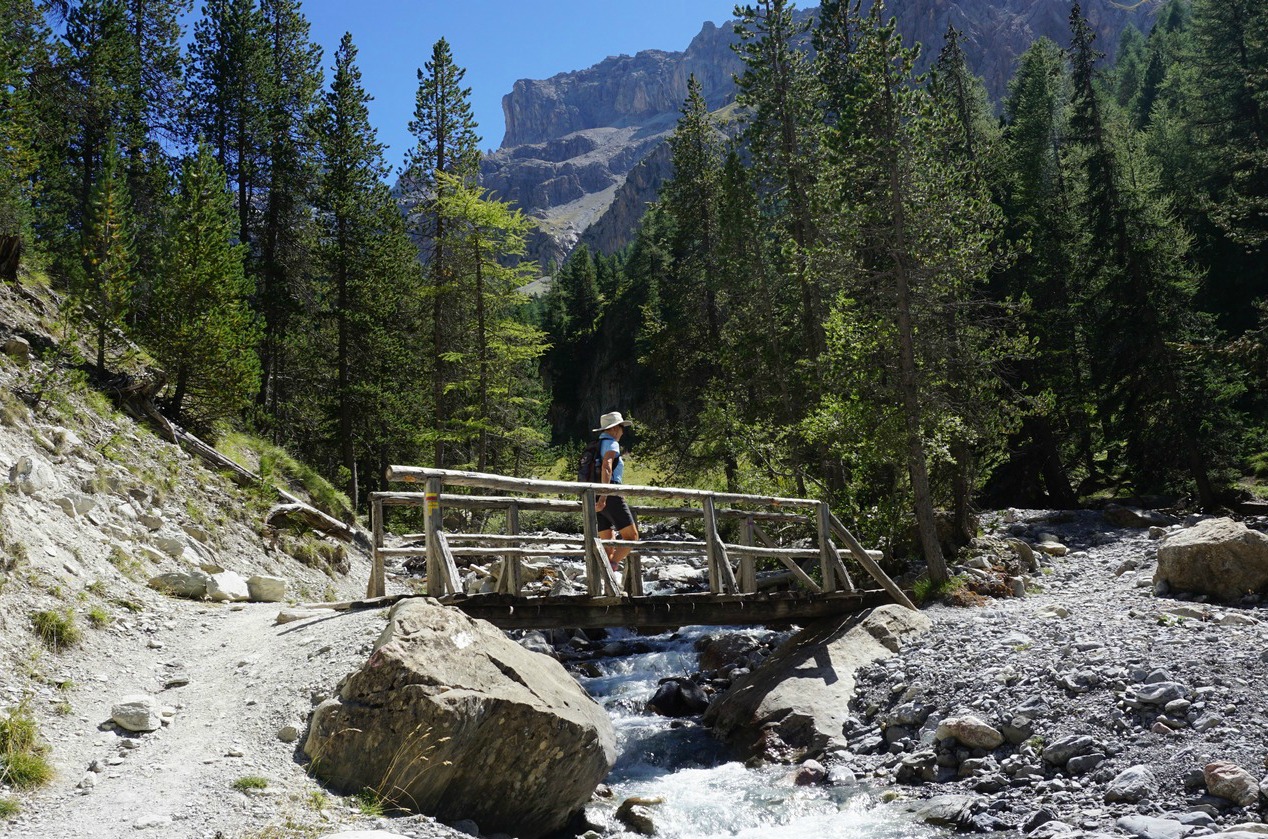
We had decided to explore Le Val d’Escreins on the first day of our three-day stay in Vars. A natural reserve situated between the Vars Valley and Queyras, it is called “little Canada” in the local guide because of its forests and steep impressive mountain ranges on both sides.
From the main D902 road, the valley can be reached along a paved although narrow road that goes as far as Refuge de Basse Rua (1760 m). The upper valley in the southeast is surrounded by 3000 m+ mountains, such as Pic de la Font Sancte (3385 m).
The Valley offers both easy trails for families and more demanding hikes that go over 3000 m. There are discovery trails where one can become acquainted with the local flora and fauna.
We planned an afternoon hike there, and chose to take the trail that went to the upper valley to an oratory, and to combine it with sentier des arbres remarquables, a path that ran parallel to the main trail for a while (marked as purple in the image).
We started from the parking at the refuge, and followed the trail (also a GR trail) to the oratory following the Rif Bel torrent (signposted and marked with purple signs). At about 2100 m elevation, we forked left (the GR trail continued southeast), and started to ascend more steeply, still mainly in the woods. The oratory came into sight just above the tree line at about 2300 m elevation.
On the way back, we took the right-hand trail a bit below the oratory signposted as arbres remarquables. The forest was beautiful as expected, but not exceptional. However, the path was better than the one we climbed on the way up. We soon joined the main trail again, and headed back to the starting point.
Elevation gain: About 560 m
Duration: 2 h to the oratory, 1h 15 back.
Map: IGN 3537 ET Guillestre, Vars, Risoul
Distance: About 10,4 km

La Merenda is a tiny restaurant in Vieux Nice that still serves authentic Niçoise cuisine. It all started in 1966 when Jean and Christiane Giusti opened the restaurant not far from the Cours Saleya. La merenda in nissart means a snack.
In 1996 Dominique Le Stanc, the famous 2-star chef from Negresco, took over. He brought his expertise to La Merenda respecting the culinary traditions of the region.
There are small wooden tables that can only be reserved by going there personally. No cheques or credit cards are accepted, and you cannot phone the restaurant. If Le Stanc’s bicycle is parked in front of La Merenda, it means that the restaurant is open. It is closed Saturdays and Sundays.
The menu features classic Niçois dishes: pissaladière, stockfish, pâtes aux pistou, sardines farcies, daube de bœuf à l’orange…The menu changes slightly according to the season. This is where you come when you want to taste beautifully prepared local cuisine.
We have visited Le Merenda before in summertime which is the best season for the cuisine du soleil of Nice. At quarter past 12 on a July Monday the tiny restaurant was already full. We were again just as impressed by the happy and simple atmosphere and great food with local wine.
For starters, we chose Tarte à la tomate and Beignets de fleur courgette. For main courses, we had Petits farcis et mesclun and Lentilles saucisses “Perugina”. Don’t worry about the French names of the dishes, they can explain them in English if needed.
And in La Merenda you can well order dessert because the portions are modest in size. We both had Salade de peches aux framboises. Delicious!

We got inspiration for this hike called Les Crêtes de la Selle from a hiking booklet purchased from the Var tourist office.
It was our 3rd hiking day in Vars. As on the day before, this hike started from the charming village of Ste-Catherine (10 minutes by car from les Claux, the main resort in the Vars Valley). We used the same parking in front of the school (parking des écoles).
La Selle (2405 m) is actually a point on the ridge called Les crêtes de la Selle, and also the highest point of this loop trail.
We soon saw that this trail was much less frequented than the two previous itineraries. We hiked along a dirt road south-southeast till we crossed a bridge (Pont de la Salce) over the Chagnon Torrent, then continued along a good trail in the woods named Bois de Laver. There were yellow markings. Once over the tree line, we continued in the same general direction having the summit of Paneyron in front of us, and Peynier with its mast on the right-hand side. The landscape consisted of vast alpine meadows, with lot of animal-made paths.
Eventually we reached Cabane du Vallon, and a big flock of cattle nearby. At the hut, we turned 180° following the trail that still climbed towards the ridge. The markings were perhaps a bit unclear (and some markings had been toppled, the cows perhaps!) as we took the wrong trail. We soon saw the signpost at La Selle (pictured), hiked there, and could start our descent to the Chagnon Torrent Valley. Once there, we followed the torrent and descended back to the dirt road that we had used in the morning.
We didn’t see any other hikers (or herders) up on the ridge. Only on the way down, there was a couple enjoying their picnic by the torrent.
This was another almost clear day, and we could again enjoy the views to Les Ecrins in the north, La Mortice and Point Jean Rostand in the east.
Duration: 5 h
Climb: 660 m
Distance: 14,5 km
Map: IGN 3537 ET Guillestre, Vars, Risoul








